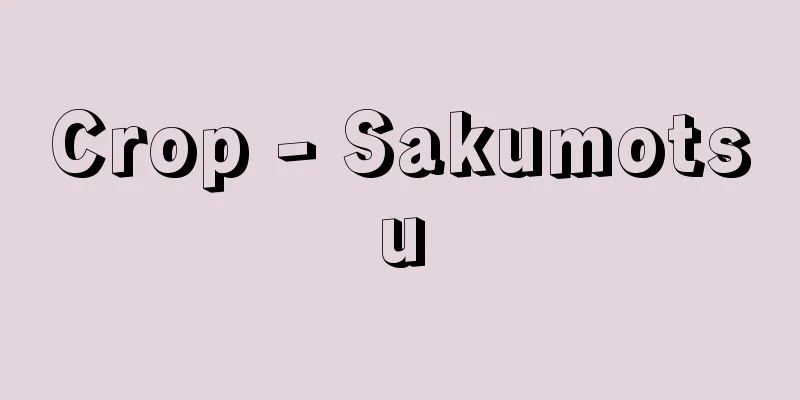Crop - Sakumotsu

|
A plant is one whose propagation and growth are protected and managed by humans for use in agriculture. For example, rice is a crop that requires tilling the paddy fields, sowing the seeds, transplanting the seedlings, and protecting and managing it until harvest in order to produce the agricultural product. However, in some areas of Southeast Asia, the grains of rice that grow wild in marshes are collected and eaten, in which case they cannot be considered crops. In this way, a crop does not refer to a specific species of plant, but can only be called a crop if it is used for agriculture. About 10,000 years ago, humans, who had previously lived a nomadic life centered on hunting, began to live more settled lives, which is said to have been the trigger for the start of agriculture, and at the same time crops were born. As agricultural culture developed, the variety of crops increased, and these were improved to increase agricultural production, and spread from their place of origin to all parts of the world. Currently, it is said that there are over 2,300 types of crops in the world, of which approximately 500 are cultivated in Japan. Crops are classified based on a comprehensive assessment of their cultivation method, commercial value, intended use, utilized parts, botanical classification, etc. According to general classification, crops are broadly divided into agricultural crops and horticultural crops. Agricultural crops can withstand relatively rough cultivation management and can be produced in large quantities. On the other hand, horticultural crops require precise cultivation management and have a relatively high commercial value per individual. Agricultural crops are divided into food crops, industrial crops, feed crops, and green manure crops depending on their intended use. Food crops are grains such as rice, wheat, and soybeans, and tubers such as sweet potatoes and potatoes, and are crops that serve as staple foods and energy sources for human life. Industrial crops are crops that are used as raw materials for industry and crafts. Depending on their uses, crops are subdivided into starch and thickening crops (sweet potato, konjac, etc.), sugar crops (sugarcane, sugar beet, etc.), wax crops (soybean, peanut, safflower, oil palm, etc.), aromatic oil crops (vanilla, lavender, jasmine, etc.), spice crops (pepper, cinnamon, wasabi, etc.), luxury crops (tea, coffee, tobacco, etc.), fiber crops (cotton, hemp, rush, paper mulberry, etc.), rubber and resin crops (hevea rubber, Panama rubber, sumac, etc.), tannin crops (wattle, persimmon, etc.), dye crops (indigo, safflower, etc.), and medicinal crops (ginseng, coptis, hops, etc.). Forage crops are crops that are used as feed for livestock and poultry, and there are many types such as corn, sorghum, orchard grass, Italian ryegrass, alfalfa, red clover, etc. Green manure crops are crops such as milk vetch that are plowed into fields to use as fertilizer. Horticultural crops are classified as vegetables, fruit trees, and ornamental crops. Depending on the part of the plant that is used, vegetables are divided into fruit vegetables (cucumbers, eggplants, broad beans, etc.), flower vegetables (cauliflower, artichokes, etc.), stem vegetables (asparagus, burdock, kohlrabi, etc.), leafy vegetables (cabbage, komatsuna, spinach, etc.), and root vegetables (radishes, carrots, lotus, etc.). Fruit trees are mainly woody plants whose fruits are edible, and include apples, pears, peaches, citrus fruits, and grapes. Nuts such as chestnuts and almonds are also included in the fruit category. Ornamental crops are grown for their flowers or leaves for decorative purposes, and there are many types such as chrysanthemums, orchids, and ferns. [Hoshikawa Kiyochika] Crop tabooA custom that discourages the cultivation of certain crops. There is a belief in the gods that cultivate agricultural crops. Rice cultivation ceremonies to welcome the rice god are seen nationwide. From sowing to harvesting, offerings are made to the rice god at the water outlet of the field. This is also sung in the lyrics of rice planting songs. There are many popular beliefs and taboos regarding agricultural work. There are days that are considered to be auspicious or unlucky for agricultural work. This is extremely common in rice cultivation, and there are many "bad" days from sowing to harvesting. There are days called Naegetsu and Naeyaku, and on these days it is said that seedlings should not be taken or rice planted. There are fewer "bad" days for field crops than for rice cultivation, but on the 4th and 9th of the month, vegetables are not sown, a custom known as Shinakuna. In April, burdock is not cultivated, a custom known as Shigobou. Unlike rice farming, there are household or village taboos against not growing or eating certain crops. In Fukushima Prefecture, these are called kare (family crops). Crops of this type include sorghum, corn, cucumbers, and pumpkins. The reason for this is said to be that, for example, in the case of sorghum, an ancestor of the family was killed by the enemy in a sorghum field when he fled after losing a battle. Another example of a village taboo is that in land where Tenno is worshipped as the tutelary deity, cucumbers are not eaten because a sliced cucumber resembles the tutelary deity's crest. [Oto Tokihiko] [Reference] |Source: Shogakukan Encyclopedia Nipponica About Encyclopedia Nipponica Information | Legend |
|
農業に利用するために、人が繁殖と生育を保護・管理する植物。たとえばイネは、農業生産物である米をとるために、水田を耕し、種(たね)を播(ま)き、苗を移植し、収穫までの期間、保護・管理する作物である。ところが東南アジアの一部の地域においては、湿原に野生するイネからその子実を採集して食用としており、この場合は作物とはいえない。このように、作物とは、ある特定の種(しゅ)の植物をさすのではなく、農業に供せられる場合に限って作物とよびうる。 いまから約1万年前、それまで狩猟中心の移動生活をしていた人類が、ある程度定住生活をするようになり、それがきっかけで農業を始めたといわれるが、農耕と同時に作物は誕生した。農耕文化が発達するにつれて作物の種類は増え、それらは農業生産を高めるように改良され、また原産地から世界各地へと伝播(でんぱ)された。 現在、作物は全世界に約2300種余りあるといわれ、そのうち日本で栽培される作物は約500種ほどである。作物は、その栽培方法や商品価値、利用目的、利用部分、植物学的分類などを総合的に判断して分類されている。一般的分類によると、作物は農作物と園芸作物とに大別される。農作物は比較的粗放な栽培管理に耐え、まとまった量を生産できる。一方、園芸作物は精度の高い栽培管理を必要とし、1個体当りの商品価値が比較的高い。農作物は利用目的により、食用作物、工芸作物、飼料作物、緑肥作物に分けられる。 食用作物とはイネやムギ類、ダイズなどの穀物やサツマイモ、ジャガイモなどのいも類などで、主食をはじめ人間生活のエネルギー源となる作物である。工芸作物とは工業や工芸の原料とするための作物である。用途によって、デンプンおよび糊料(こりょう)作物(サツマイモ、コンニャクなど)、糖料作物(サトウキビ、テンサイなど)、油蝋(ゆろう)料作物(ダイズ、ラッカセイ、ベニバナ、アブラヤシなど)、芳香油料作物(バニラ、ラベンダー、ジャスミンなど)、香辛料作物(コショウ、シナモン、ワサビなど)、嗜好(しこう)料作物(チャ、コーヒー、タバコなど)、繊維料作物(ワタ、アサ、イグサ、コウゾなど)、ゴムおよび樹脂料作物(パラゴム、パナマゴム、ウルシなど)、タンニン料作物(ワトル、カキなど)、染料作物(アイ、ベニバナなど)、薬料作物(チョウセンニンジン、オウレン、ホップなど)などに細分される。飼料作物とは家畜や家禽(かきん)の餌(えさ)とする作物で、トウモロコシやソルガム、オーチャードグラス、イタリアンライグラス、アルファルファ、レッドクローバーなど種類が多い。また、緑肥作物とはレンゲソウなどのような田畑にすき込んで肥料とする作物をさす。 園芸作物は野菜、果樹、観賞作物に区分される。野菜は利用部分によって、果菜類(キュウリ、ナス、ソラマメなど)、花菜類(カリフラワー、アーティチョークなど)、茎菜類(アスパラガス、ウド、コールラビーなど)、葉菜類(キャベツ、コマツナ、ホウレンソウなど)、根菜類(ダイコン、ニンジン、ハスなど)に分ける。果樹はおもに木本植物の果実を食用とするもので、リンゴ、ナシ、モモ、ミカン類、ブドウなどがある。また、クリやアーモンドなどのナッツ類も果実に含まれる。観賞作物とは、花や葉などを観賞用に供するために栽培するもので、キクやラン、シダ植物など多くの種類がある。 [星川清親] 作物禁忌特定の作物を栽培することを忌む風習。農作物にはそれを育成する神々の信仰がある。稲作には田の神を迎えて祭る儀礼が全国的にみられる。種播(たねま)きから収穫まで田の水口(みなくち)に田の神を祀(まつ)って供え物をする。このことは田植唄(うた)の歌詞にも歌われている。農作物の作業に関していろいろな禁忌俗信が言い習わされている。農作業について日の吉凶ということがある。稲作にはこれがきわめて多く播種(はしゅ)から収穫まで「よくない」という日が多い。苗月、苗厄という日があり、この日は苗をとらぬとか、田植をしないとかいう。畑作については稲作ほど「よくない」日というのは少ないが、四菜九菜(しなくな)といって月の4日と9日には菜を播かない。4月には死牛蒡(しごぼう)といってゴボウをつくらない。畑作物には稲作と違って家または村で、ある種の作物をつくらぬとか食べないという禁忌がある。福島県ではこれを家例(かれい)といっている。この種の作物ではモロコシ、トウモロコシ、キュウリ、カボチャなどがある。その理由として、たとえばモロコシならば、家の先祖が戦いに敗れて逃げたとき、モロコシ畑で敵に殺されたから、などと言い伝えている。また村で禁忌としている場合は、たとえば天王(てんのう)様を氏神としている土地でキュウリを食べないのは、それを輪切りにしたものが氏神の紋所に類似しているから、といったたぐいである。 [大藤時彦] [参照項目] |出典 小学館 日本大百科全書(ニッポニカ)日本大百科全書(ニッポニカ)について 情報 | 凡例 |
<<: Crop season - Sakumo Tsukisetsu
>>: Zakum oil field - Zakum Yuden (English spelling)
Recommend
Knowledge
…It was quickly adopted into French as a European...
ATP (Tennis)
…The winners were M. Mecirz (Czechoslovakia) in t...
Yasuo Kawamura
… Japanese speed skating made remarkable progress...
Kuppelhorizon
…Usually it is made of a vertical curved surface ...
Tenth Night - Tokanya
This harvesting event is held on the 10th day of ...
Togi [town] - Togi
A former town in Hakui County in northern Ishikawa...
Texas sage (English spelling)
... The species of the Salvia genus that are ofte...
Royal Niger Company
The Royal Niger Company was a British company esta...
Secret illustrated words of the Hosso sect
This illustrated scroll from the late Kamakura per...
Antifogging coated glass
When the glass is used under conditions that cause...
navagrāha (English spelling)
…It is included in the 104th volume of the Kaigen...
Indoctorination - indoctorination (English spelling)
The original meaning of the term originated from ...
Obi cedar - Obisugi
Imo Shochu from Miyazaki. The name of the sake com...
Karl Ludwig Kahlbaum
1828‐99 German psychiatrist. Born in Dresden, he s...
Kutscher, A.
… [Assimilation through seeing] But how does assi...









